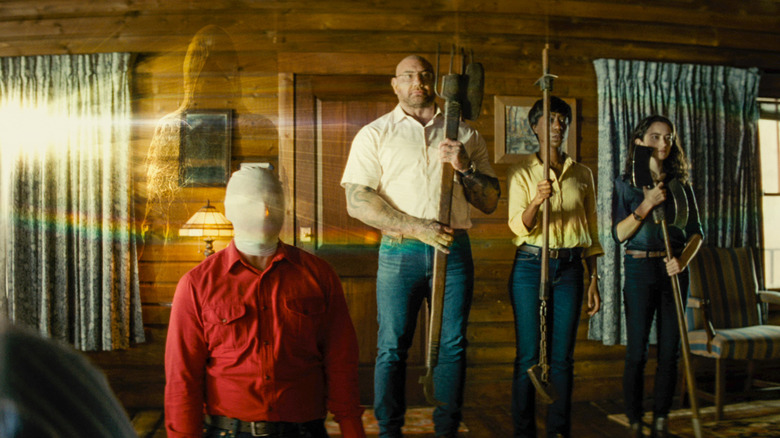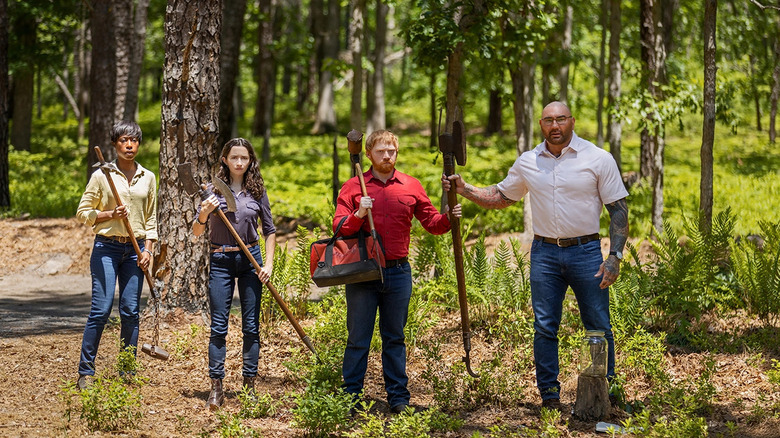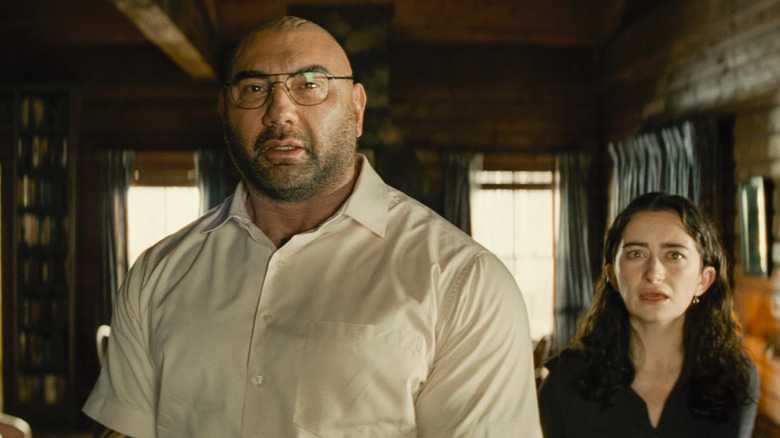One Of The Coolest Details In Knock At The Cabin Hides In Plain Sight
This post contains spoilers for "Knock at the Cabin."
When four strangers interrupt your vacation by breaking into your cabin with horrifying homemade weapons and declaring that the end of the world is coming, you might not pay too much attention to what they're wearing. That's especially true of M. Night Shyamalan's new thriller "Knock at the Cabin," in which the home invaders are wearing a pretty unremarkable uniform of blue jeans, brown belts, and button-down shirts.
But these outfits aren't just something the strangers threw on. As they explain to the family they've taken captive — dads Eric (Jonathan Groff) and Andrew (Ben Aldridge), and their adopted daughter Wen (Kristen Cui) — they were brought to the cabin after being plagued by visions of the apocalypse. They're here to present Andrew, Eric, and Wen with a chance to prevent the end of the world by sacrificing a member of their own family. This is also something they saw in their visions, right down to the clothes that they would be wearing.
If you have an eye for detail in movies, and you're familiar with the Bible's Book of Revelation, then you might have noticed that the color of the home invaders' shirts is a clue to their role in the end of the world — even before Eric identifies them as the four horsemen of the Apocalypse.
The four horsemen
Leonard (Dave Bautista), Adriane (Abby Quinn), Sabrina (Nikki Amuka-Bird), and Redmond (Rupert Grint) aren't exactly the four horsemen we're used to seeing: Death, Famine, War, and Conquest. Redmond, whom Eric identifies as the embodiment of malice, wears a red shirt, matching the description of War, who rides a red horse. But the other three are more like inverted versions of the traditional horsemen.
Death, perhaps the most famous of the four horsemen, is said to ride a pale horse, with some translations describing the horse as pale green or grey. Sabrina, a nurse who tends to Eric's concussion after he's injured in the initial fight, is identified as a manifestation of another human trait: healing, effectively the opposite of Death. Sabrina wears a pale yellow shirt.
Then there's Leonard, the leader of the group. Eric says that Leonard represents guidance, and his white shirt implies that Leonard is an analog for the first of the four horsemen, who rides a white horse. Though some interpretations of the Bible identify this horseman as Pestilence, and that's certainly the version that caught on in pop culture, the Book of Revelation only says that the first horseman "came out conquering and to conquer." When introducing himself to the family, Leonard explains that he is a teacher and sports coach for young kids. It's still the role of a leader, like the horseman who rides out first in the Bible but mirrored: instead of Conquest, Leonard represents more positive qualities of leadership.
Finally, there's Adriane, who wears a black shirt and strongly reflects the apocalyptic figure who rides a black horse, Famine. Only instead of starving people, Adriane works as a line cook. She even cooks breakfast for Wen, leading Eric to identify Adriane as the embodiment of nurturing.
The Day of Judgment
"Knock at the Cabin" is an interpretation of the Day of Judgment in the Bible, only in this version of the story, it's Andrew, Eric, and Wen who are called upon to do the judging. Each time they refuse to choose a member of their own family to sacrifice, one of the four horsemen pulls a white hood over their head, declares that "a part of humanity has been judged," and is then brutally killed by their associates. The strangers claim that each time one of them is killed, they are unleashing an apocalyptic plague upon the world, and news reports indicate that this is true.
The movie is less ambiguous than the book about whether or not the apocalypse is real, but it does leave some questions unanswered. For example, some of the plagues — like a lethal virus that mainly affects children — had already begun before the Four Horsemen arrived. This leads Andrew to argue that the apocalyptic events and the choices they make in the cabin are just coincidences. The captives also beg the four horsemen not to kill each other to unleash the plagues, asking them why they don't simply turn around and leave.
The answer to this is that the strangers are both harbingers of the apocalypse and victims of it; each of them represents an aspect of humanity, and they've come to the cabin to present themselves for judgment. As they see it, one of them is obligated to die each time the family judges a portion of humanity to not be worth saving. Though it seems like they have all the power, they're actually begging for their lives.


